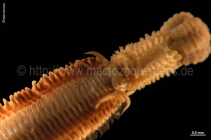RAS name details
Anaitides Czerniavsky, 1882
152426 (urn:lsid:marinespecies.org:taxname:152426)
unaccepted (subjective synonym)
Genus
- Species Anaitides adarensis (Benham, 1927) accepted as Phyllodoce adarensis Benham, 1927 (unaccepted > superseded combination)
- Species Anaitides bowersi (Benham, 1927) accepted as Paranaitis bowersi (Benham, 1927)
- Species Anaitides longipes (Kinberg, 1866) accepted as Phyllodoce longipes Kinberg, 1866
- Species Anaitides madeirensis (Langerhans, 1880) accepted as Phyllodoce madeirensis Langerhans, 1880
- Species Anaitides patagonica (Kinberg, 1866) accepted as Phyllodoce patagonica (Kinberg, 1866)
marine, brackish, fresh, terrestrial
recent only
feminine
Czerniavsky, Voldemaro. (1882). Materialia ad zoographiam Ponticam comparatam. Fasc. III Vermes. [third part]. <em>Bulletin de la Société Impériale des naturalistes de Moscou (= Byulletin' Moskovskogo obshchestva ispytatelei prirody).</em> 57(1): 146-198., available online at http://biodiversitylibrary.org/page/34267696
page(s): 148 and 158-159 [details]
page(s): 148 and 158-159 [details]
Read, G.; Fauchald, K. (Ed.) (2025). World Polychaeta Database. Anaitides Czerniavsky, 1882. Accessed through: RAS (Eds.) (2025) Register of Antarctic Species at: https://ras.biodiversity.aq/aphia.php?p=taxdetails&id=152426 on 2025-09-12
RAS (Eds.) (2025). Register of Antarctic Species. Anaitides Czerniavsky, 1882. Accessed at: https://ras.biodiversity.aq/aphia.php?p=taxdetails&id=152426 on 2025-09-12
Date
action
by
original description
Czerniavsky, Voldemaro. (1882). Materialia ad zoographiam Ponticam comparatam. Fasc. III Vermes. [third part]. <em>Bulletin de la Société Impériale des naturalistes de Moscou (= Byulletin' Moskovskogo obshchestva ispytatelei prirody).</em> 57(1): 146-198., available online at http://biodiversitylibrary.org/page/34267696
page(s): 148 and 158-159 [details]
source of synonymy Hartmann-Schröder, G. (1996). Annelida, Borstenwürmer, Polychaeta [Annelida, bristleworms, Polychaeta]. <em>2nd revised ed. The fauna of Germany and adjacent seas with their characteristics and ecology, 58. Gustav Fischer: Jena, Germany. ISBN 3-437-35038-2.</em> 648 pp. (look up in IMIS) [details] Available for editors
status source Pleijel, Fredrik. (1991). Phylogeny and classification of the Phyllodocidae (Polychaeta). <em>Zoologica Scripta.</em> 20(3): 225-261., available online at https://doi.org/10.1111/j.1463-6409.1991.tb00289.x
note: Anaitides again treated as a junior synonym of Phyllodoce [details] Available for editors
status source Pleijel, F. (1988). <i>Phyllodoce</i> (Polychaeta, Phyllodocidae) from Northern Europe. <em>Zoologica Scripta.</em> 17(2): 141-153., available online at http://dx.doi.org/10.1111/j.1463-6409.1988.tb00091.x
note: Anaitides treated as a junior synonym of Phyllodoce [details] Available for editors
status source Salazar-Vallejo, Sergio I. (2022). New species of hesionid and phyllodocid polychaetes (Annelida, Errantia) from Clipperton Island. <em>Zoosystema.</em> 44(1): 1-26., available online at http://zoosystema.com/44/1
note: Anaitides is treated as distinct from Phyllodoce where it has been a synonym for over 30 years. [details] Available for editors
subsequent type designation Bergström, Erik. (1914). Zur Systematik der Polychætenfamilie der Phyllodociden. <em>Zoologiska bidrag från Uppsala.</em> 3: 37-224, plates I-V., available online at http://biodiversitylibrary.org/page/36924250
page(s): 77; note: Phyllodoce groenlandica Örsted, 1842 designated as type species [details]
page(s): 148 and 158-159 [details]
source of synonymy Hartmann-Schröder, G. (1996). Annelida, Borstenwürmer, Polychaeta [Annelida, bristleworms, Polychaeta]. <em>2nd revised ed. The fauna of Germany and adjacent seas with their characteristics and ecology, 58. Gustav Fischer: Jena, Germany. ISBN 3-437-35038-2.</em> 648 pp. (look up in IMIS) [details] Available for editors
status source Pleijel, Fredrik. (1991). Phylogeny and classification of the Phyllodocidae (Polychaeta). <em>Zoologica Scripta.</em> 20(3): 225-261., available online at https://doi.org/10.1111/j.1463-6409.1991.tb00289.x
note: Anaitides again treated as a junior synonym of Phyllodoce [details] Available for editors
status source Pleijel, F. (1988). <i>Phyllodoce</i> (Polychaeta, Phyllodocidae) from Northern Europe. <em>Zoologica Scripta.</em> 17(2): 141-153., available online at http://dx.doi.org/10.1111/j.1463-6409.1988.tb00091.x
note: Anaitides treated as a junior synonym of Phyllodoce [details] Available for editors
status source Salazar-Vallejo, Sergio I. (2022). New species of hesionid and phyllodocid polychaetes (Annelida, Errantia) from Clipperton Island. <em>Zoosystema.</em> 44(1): 1-26., available online at http://zoosystema.com/44/1
note: Anaitides is treated as distinct from Phyllodoce where it has been a synonym for over 30 years. [details] Available for editors
subsequent type designation Bergström, Erik. (1914). Zur Systematik der Polychætenfamilie der Phyllodociden. <em>Zoologiska bidrag från Uppsala.</em> 3: 37-224, plates I-V., available online at http://biodiversitylibrary.org/page/36924250
page(s): 77; note: Phyllodoce groenlandica Örsted, 1842 designated as type species [details]
 Present
Present  Inaccurate
Inaccurate  Introduced: alien
Introduced: alien  Containing type locality
Containing type locality
